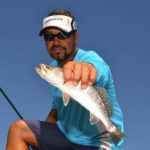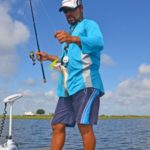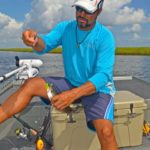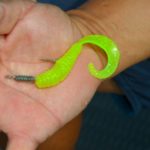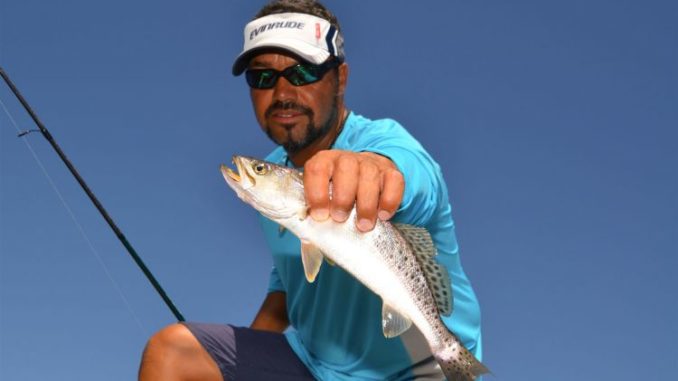
Find and exploit trout highways now
“I call them ‘highways’,” said the deeply tanned lower Lafourche Parish fishing guide.
“Oh yeah, I can dig it,” I said. “During the fall transition times, speckled trout search out deep bayous and canals to travel from the lower bays to the upper parts of the estuaries.”
“Well, not exactly,” replied Chad Billiot (Marsh Rat Guide Service, 985-637-5058).
“Transition is when the trout move from their spawning grounds up into interior marshes. That’s mid-September to mid-October. A ‘flip-around’ occurs from the first week in March to mid-April, when they move back the other way.”
The word ‘highway’ brings to the human mind a picture of a narrow route. But not to Billiot. “A highway to me is not the deeper canals and bayous. Highways aren’t bays or lakes either. A highway to me has no more than 3 feet of water.
“Trout rapidly move through bays and lakes rapidly into shallow marshes, but not yet those deep inside where they will winter. These fish spent the summer from Grand Isle to Fourchon. In the dead of winter, they will be as far up as Little Lake out of Clovelly Farms.
“They are in shallow waters between the two areas feeding very aggressively. Ninety percent of their forage is shrimp because there are so many shrimp still there. We don’t get strong enough cold fronts to push most of the shrimp out of the marsh until late November.
“They are feeding, but they are moving and they don’t stage anywhere. Every day is a different day.
“But the trout don’t move in a diffuse, random way. They do have a routine and they do follow the same pattern.
“You might catch a certain size one day and miss them a day or two later. Then you will catch a different crop as it comes through.”
Billiot started the day south of Leeville, north of Williams Canal and east of Highway 1, within sight of the Leeville Bridge.
“Ugh, the water is dirty,” I tossed to Billiot. “That’s never good for trout.”
“That doesn’t mean they aren’t here,” he laughed. “And that’s why they make popping corks. Dirty water is normal for transition time.”
Lots of other things are the same for trout fishing, in or out of transition though, he said. Tide ranges of 0.5 or more are best. You need current or tidal movement for fish to run the highway.
But a big difference is wind, normally the bane of speckled trout fishermen. The ideal, he said, is 15 miles per hour or more. “It makes them move and feed. I think that it may oxygenate the water.
“Wind seems to be the big trigger to kick-start their movement during transition.”
Billliot began whipping the water with his spinning tackle while he kept the boat moving into new water with his trolling motor. “I’m not a big fan of baitcasters with a popping cork,” he said. “I can cast further and don’t get bird’s nests.”
He is dedicated to 2500 Shimano Stradic reels (He’s been using them since his early teens) on 7-foot 2-inch medium weight Shimano Crucial rods with extra fast tips. His reels are spooled with PowerPro Maxcuatro braided line.
He likes Maxcuatro braid because of its thinner diameter. The 20-pound test that he uses has the diameter of 4-pound test monofilament.
His preference in corks is for oval corks with beads mounted on flex wire. His favorite is made by Bass Assassin Fishing Lures.
Corks are an essential item. “I’m not expecting to have clean water in transition,” he explained. “The key to fishing success is a noisy presentation.”
Below the cork is 24 inches of 30-pound test Gamma fluorocarbon line. “Fluorocarbon is not a necessity during transition,” he noted, “but this brand is easy to tie.”
As for lures, he is a one-trick pony. “My go-to for any condition is a 3-inch, chartreuse Bass Assassin curly tail grub. I will fish this from September to late April. It is easy for fish to see in clean or dirty water — sometimes I mean really dirty water!”
He mounts his grub on what he called a shrimp impaler hook, also made by Bass Assassin. It’s really a 1/32-ounce weighted hook, rather than a jighead.
“Jigheads are too heavy,” he explained. “This has a slower fall after popping the cork. A big plus is that the grub is almost impossible for a fish to strip off the hook.”
In the course of the day, he stressed over and over again his preference for wind — over 15 miles per hour and as high as 25 miles per hour.
“Wind is really a trigger! Water temperatures are still high in September and barometric pressures are fairly stable.”
Action was slow at the first stop, so Billiot moved southeast to an eroded marsh in what is marked on older maps as the Wisner Tract, an old Louisiana Department of Wildlife and Fisheries wildlife management area.
He began picking up small keeper speckled trout, not every cast, but often enough to make things interesting. Transition time isn’t trophy trout time.
He threw a glance over his shoulder as he unhooked another fish. “I have to admit that it’s a little intimidating for the average person — vast areas of same-looking shallow waters with scattered small islands of grass.
“A lot of people now simply ride the area and look for tell-tale signs. That’s why the skeg on my motor looks the way it does.” Billiot ticked off three things that always catch his attention.
First, and a big one, are “current lines” in the water. Typically, they run down-current from points of land and islands. A current line is recognizable by having different water surface patterns on each side.
Easier to overlook, but nearly as important is the presence of “nervous water.” The presence of a school of baitfish, like mullet, creates a surface wave pattern different than that of the other water nearby. Billiot described it as “almost trembling in appearance.”
Finally, the presence of gulls working over a spot will usually indicate feeding predator fish, just as it does in bays in the summertime.
Billiot moved the boat somewhat north into the broken marsh (a term for highly eroded marshes with lots of open water mixed with small grassy islands) near Bayou Fer Blanc.
It looked much like the first stop, lots of shallow water in fragmented marshes. Eliminating the lower bays and lakes that trout summer in and the deep interior overwintering marshes as targets still left a lot of water to search.
At first glance it was bewildering and intimidating. A lot of the places Billiot fished didn’t even have names.
“I call them highways because fish use them year after year, even after erosion,” he repeated, apparently to bolster my confidence.
The spot he was trolling around and hammering was a perfect case in point. It was essentially a square of open water of about 50 acres or so. A current from a bayou on one side fed through the pond and out through another bayou on the opposite side of the pond. The moving water showed as a visible current line.
He cast into seemingly featureless open water, taking trout after trout.
“Where the current line is running now was a bayou that held oysters. The bayou banks are gone, but the oysters are still there.
“One day I was pounding the bank here for redfish. I spotted a visible current line through the middle of the pond. I cast into it and started catching trout like crazy.
“In the 20 years since, erosion has claimed a lot of bank features, but the trout are still here. My redfishing has gone thumbs down because of less bank, but the trout fishing is fine.”
When the bite slowed, Billiot moved to the Bay Jaques-Bay Rambo area. He worked the broken marshes like a relentless casting machine.
Besides his rod and reel, line and lure, he claims that his most important tools are his trolling motor and his two Power-Pole Micro Anchors. The trolling motor allows him to work a current line over its length.
In broken marshes, several channels of current off of islands often exist. With his trolling motor, he can quickly move from one to another. But strong winds of the types he so loves often make trolling motor work difficult.
Under these conditions, he will go to spots with strongly defined water surface features and use his Micro Anchors to stabilize the boat. After working the spot, he will move and re-anchor until he finds the fish.
When last seen, Chad Billiot, white teeth gleaming happily in his dark face, was pumping out casts with his unique two-handed casting technique.
“As long as water temperatures are in the 70s and 80s, trout will be scattered through the marsh in waters never over 3 feet deep,” he yelled.
And he will be there catching them!
